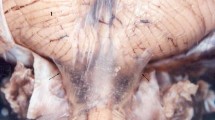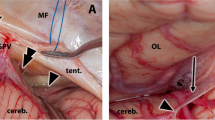Abstract
An understanding of the microsurgical anatomy of the arachnoid membranes and the subarachnoid cisterns is important in minimally invasive neurosurgery. But the topography of the arachnoid membranes has not been completely elucidated. The description of the distribution and the configuration of the intracranial arachnoid membranes is still a subject of controversy. In order to clarify this we examined eight Han Chinese adult human cadavers under an operating microscope. The dissections were performed with microsurgical instruments and techniques without staining of the intracranial structures nor injection of colored material into blood vessels. Twenty seven arachnoid membranes were identified. They were named according to their locations and attachment. They were divided into three groups: basal, convex and trabecular arachnoid membranes. They varied greatly in appearances and configurations. They were single-leaf structured except Liliequist’s membrane, the chiasmatic membrane and the cerebellar precentral membrane. They were distributed extensively and unevenly and crisscrossed in the cranial cavity. The more complexly and intricately the blood vessels or the nerves converged or branched within the subarachnoid space, the more luxuriant and complex the arachnoid membranes and trabeculae were. The areas where the arachnoid membranes crowded most thickly in the subarachnoid space included the regions around the bifurcation of the internal carotid artery, the area around the hypothalamus, the interpeduncular cistern, the arachnoidal sheaths of the oculomotor nerve, the quadrigeminal cistern and the cisterna magna. Almost all the cranial nerves were encased by their own arachnoidal sheaths when they crossed the cisterns. The arachnoid membranes and trabeculae must be dissected or incised sharply during the operations. Thorough knowledge of the anatomy of the intracranial arachnoid membranes is valuable to take full advantage of the natural anatomic landmarks and interfaces formed by them during surgery.







Similar content being viewed by others
References
Bakey L (1991) Discovery of the arachnoid membranes. Surg Neurol 36:63–68
Epstein BS (1965) The role of a transverse arachnoid membrane within the interpeduncular cistern in the passage of Pantopaque into the cranial cavity. Radiology 85:914–920
Lescanne E, Velut S, Lefrancq T et al (2002) The internal acoustic meatus and its meningeal layers: a microanatomical study. J Neurosurg 97:1191–1197
Liliequist B (1956) The anatomy of the subarachnoid cisterns. Acta Radiol 46:61–71
Lu J, Zhu XL (2003) Microsurgical anatomy of Liliequist’s membrane. Minim Invas Neurosurg 46:149–154
Matsuno H, Rhoton AL, Peace DA (1988) Microsurgical anatomy of the posterior fossa cisterns. Neurosurgery 23:58–80
Rhoton AL (2000) The posterior fossa cisterns. Neurosurgery 47:287–297
Sanon A, Loveren HRV (1999) The arachnoid and the myth of Arache. Neurosurgery 45:152–157
Vinas FC, Fandino R, Dujovny M et al (1994) Microsurgical anatomy of the supratentorial arachnoidal trabecular membranes and cisterns. Neurol Res 16:417–424
Vinas FC,Dujovny M, Fandino R et al(1996) Microsurgical anatomy of the arachnoidal trabecular membranes and cisterns at the level of the tentorium. Neurol Res 18:305–311
Vinas FC, Dujovny M, Fandino R et al (1996) Microsurgical anatomy of the infratentorial trabecular membranes and subarachnoid cisterns. Neurol Res 18:117–125
Yasargil MG, Kasdaglis K, Jain KK et al (1976) Anatomical observation of the subarachnoid cisterns of the brain during surgery. J Neurosurgery 44:298–302
Yasargil MG (1984) Microneurosurgery, vol l. Thieme Verlag, New York, pp 5–53
Yasargil MG (2002) The internal acoustic meatus. J Neurosurg 97:1014–1017
Author information
Authors and Affiliations
Corresponding author
Rights and permissions
About this article
Cite this article
Lü, J., Zhu, X.L. Characteristics of distribution and configuration of intracranial arachnoid membranes. Surg Radiol Anat 27, 472–481 (2005). https://doi.org/10.1007/s00276-005-0025-4
Received:
Accepted:
Published:
Issue Date:
DOI: https://doi.org/10.1007/s00276-005-0025-4




